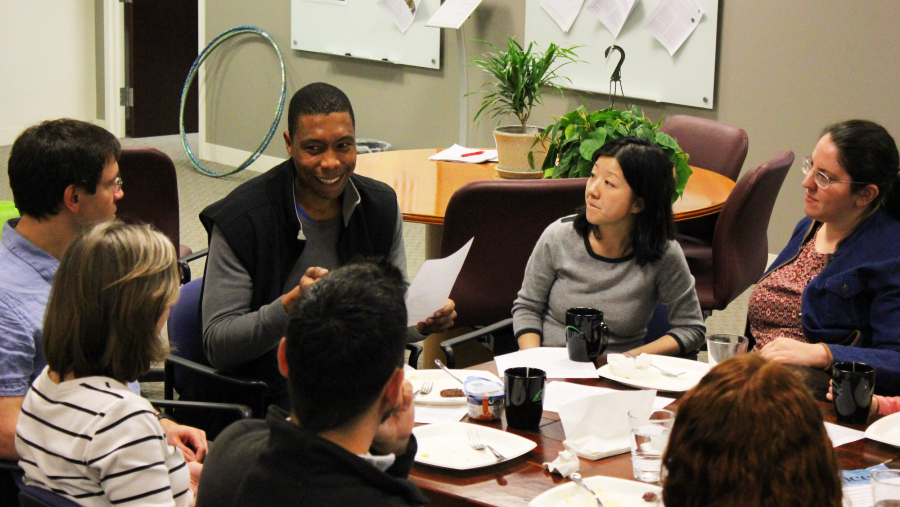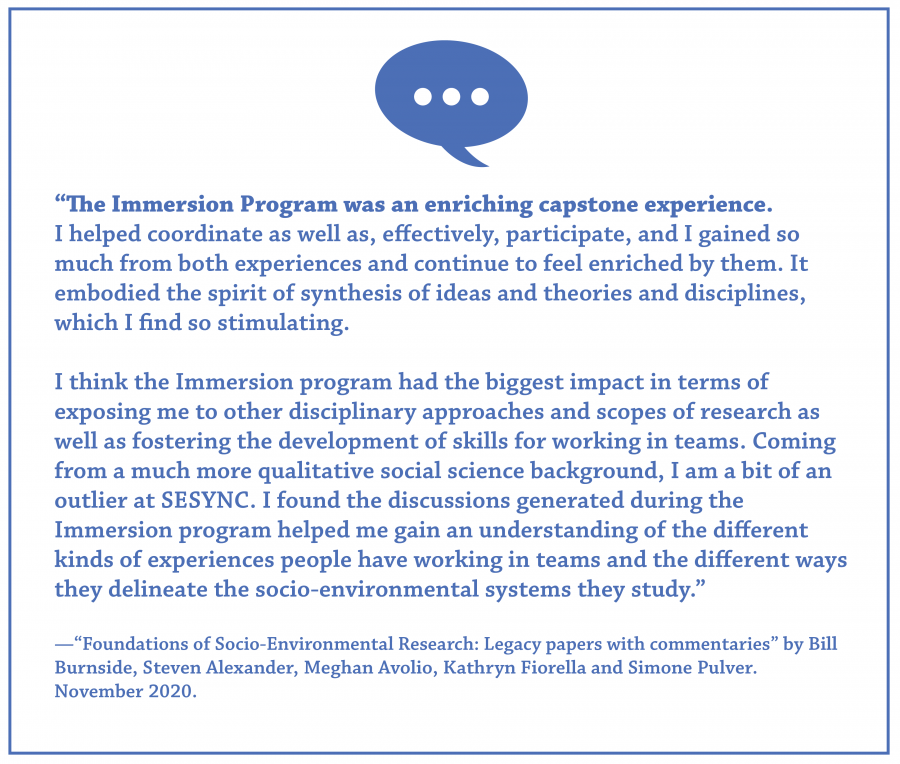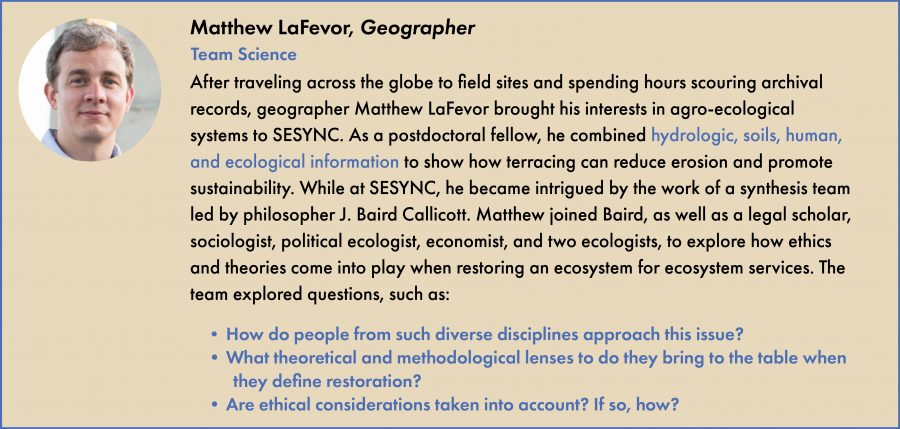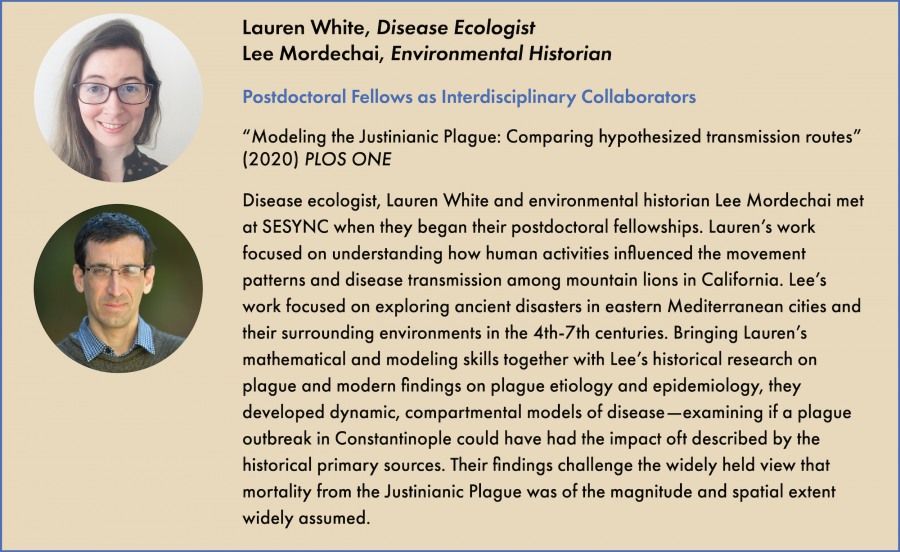
Interdisciplinary cohorts of in-residence postdoctoral fellows were central to the life of SESYNC. As 6–7 new fellows joined the cohort each year for a 2-year fellowship, SESYNC had an average of 15 in residence at SESYNC at any one time. Each cohort comprised individuals from diverse disciplines, including those who applied theories and/or methods from anthropology, ecology, economics, environmental history, geography, nursing, political science, and sociology. The fellows participated in a multi-faceted program, designed to grow capacity for advancing research, engaging in interdisciplinary collaborations, and enhancing their professional success. In addition to having extensive computational support, advanced short course opportunities, and professional and research mentoring, fellows had access to the Center’s vibrant interdisciplinary community.
Advancing Research: Postdoctoral Projects
A core part of the postdoctoral experience at SESYNC was the fellows’ design, development, and implementation of an independent research project. Fellows could develop the research proposals in consultation with a collaborating mentor, but the projects had to represent the fellows’ own original ideas. Each fellow selected their mentors based on their research topic. (Mentors could be affiliated with any organization but could not have previously worked with the fellow.) The mentor’s role was to provide advice on a fellow’s research and progress over their two-year fellowship, as well as to help extend a fellow’s collaborative network. All mentors had to sign an agreement that they would not direct a fellow’s work but rather would serve by invitation as a true collaborator. Each mentor received an honorarium, and fellows had travel funds available to them to work with their mentor in person several times a year.
SESYNC selected its postdoctoral fellows from a highly competitive applicant pool, based on expert panel reviews of submitted proposals and in-person interviews with SESYNC’s leadership and current postdoctoral fellows. Throughout their fellowship, SESYNC encouraged fellows to expand their research networks beyond their collaborating mentors; as a result, almost all SESYNC fellows joined at least one SESYNC synthesis team on a project of interest but unrelated to their core research. Often, their participation introduced the fellows to a novel research topic and/or synthesis methods and provided a rich experience in interdisciplinary team collaboration.
Professional Success: Dispositional Mentoring and Skills Training
Much of the intentional mentoring that was part of SESYNC’s program was not always transparent as such to the postdoctoral fellows. To facilitate dispositional learning, we encouraged fellows to participate in activities and events that were representative of those that they were likely to experience in their career. These experiences included: leading a research synthesis team; developing curricular materials for, and lecturing, in our short courses; hosting visiting scholars; participating on a SESYNC search committee or proposal review panel; interviewing candidates for positions; meeting with policy makers or program officers of funding entities; and undergoing annual reviews much like those done in academic or NGO settings. Individuals can be “taught” about dispositions—meaning, for example, lecturing or explaining to them the importance of being open to new ideas and ways of thinking or of developing specific skills that enhance collaboration. However, experiential “self-learning” is a powerful tool that can contribute to successful scholarly paths and contribute to becoming “practitioners” of scholarly research, teaching, and collaboration. Learning through “doing” allows each individual to negotiate the values, attitudes, and practices needed for such work.
SESYNC leadership and the fellows themselves organized numerous formal activities, intended to build specific skills or convey important information that students routinely do not receive during their graduate training. These activities varied over time, depending on interests on the part of the fellows, but they included the following:
- Communication skills and writing workshops
- Workshops on how to find research funding sources, write successful proposals, and apply feedback from constructive reviews
- Discussions on the science-policy interface facilitated by scholars or decision makers
- Visits to funding agencies where program officers gave presentations and fellows met with program officers most relevant to their research
- Data Carpentry workshops and Computational “Institutes”
- Short courses in Bayesian statistics, network analysis, agent-based modeling, and teaching using a case study method
- Career and professional development lunch meetings to provide feedback to peers on how they presented themselves in their CVs/resumes, in job letters, and on websites.
Finally, part of the training included giving and receiving evaluative feedback; fellows provided input to one another on their presentations. To help fellows understand typical researchers and faculty evaluations, each received an annual evaluation from a SESYNC leadership committee. The fellows submitted materials in advance of the spring deadline and then received a letter of evaluation that focused their research progress and their professional and scholarly engagement in the life and activities of the center.
Interdisciplinary Collaborations: Immersion Workshops
SESYNC designed the Postdoctoral Immersion Workshops to foster an interdisciplinary disposition in fellows and an appreciation for the breadth of scholarly perspectives and traditions applied to understanding human-nature relationships. SESYNC’s thesis in designing the Immersion Program was that a certain level of understanding of different disciplinary traditions was essential for truly integrative research on socio-environmental (S-E) systems. While lexicon differences are often cited as a barrier to interdisciplinary research, there is much more—there can be vast differences among researchers in their epistemic stances that determine what kind of knowledge they consider valid in research. There can be different, if not divergent, methods and methodologies, as well as variation in the extent to which research is theory-based or motivated.
With this as a backdrop, a key element of the Immersion Program was a series of highly interactive workshops in which accomplished visiting scholars presented lectures and led discussions around the theories and methodological lenses through which they approached their own work in the context of S-E systems. At the most basic level, the workshops challenged the Fellows with the following questions:

Across the 10+ years of the Immersion Program, SESYNC organized 2–3 workshops each year so that fellows had exposure to multiple topical areas over the course of their 2-year fellowship. In total, 74 eminent scholars from a diversity of disciplines led Immersion workshops at SESYNC.
Scholars assigned key readings in advance of each workshop, which comprised lectures and plenary discussions, small group discussions, and informal conversations. SESYNC research staff and leadership, as well as Immersion Program mentors, facilitated group discussions, and after the workshops, helped to distill and integrate key ideas, and catalyze the production of manuscripts by participants for submission to high-impact peer-reviewed journals. SESYNC also encouraged participants to work with one another and other scholars to produce synthetic papers or products that integrated theory and methods across disciplines to understand the dynamics of coupled S-E systems. The 2022 book, Foundations of Socio-Environmental Research published by Cambridge University Press, grew out of SESYNC workshops and is written by former SESYNC Fellows and scholars. It provides a historical perspective on publications—some of them out of print now—that were seminal to the concept of coupled human-nature relationships.
Immersion workshops had either a disciplinary focus or topical focus. For example, one workshop brought together six scholars, representing broad sociological approaches, enabling the fellows to experience how different these scholars were in their perspectives and research approaches—dispelling a common myth among some natural scientists that the social sciences are homogeneous. A workshop organized around “change” in S-E systems brought five visiting scholars to SESYNC, one of who framed his work on socio-ecological resilience in the context of adaptive cycles and stakeholder-engaged research teams. Others focused on the transitional or step-changes in urban S-E systems and barriers to change in law and institutions affecting S-E systems. SESYNC also hosted workshops focused on methodological approaches that are applied across disciplines but are sometimes referred to using different names.


